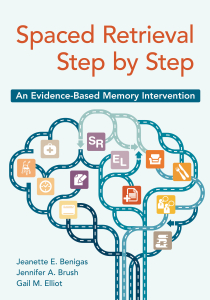Spaced Retrieval: Enabling People with Memory Loss to Lead More Independent Lives
 Twenty years ago while working at a long-term care community, I learned about a memory-training strategy called Spaced Retrieval, which is used to teach people with memory loss new or previously known information. I began using this strategy with people who had Alzheimer’s disease, Parkinson’s disease, traumatic brain injury, aphasia and other conditions that cause memory loss. The results amazed me – by practicing verbalizing information, my clients were able to remember important facts, names and tasks that were part of their daily lives over increasing amounts of time. I began to teach Spaced Retrieval to occupational therapists, physical therapists and other speech-language pathologists, and we began to teach the residents of the long-term care community to remember essential information such as how use their walkers, lock their wheelchair brakes, find their rooms and swallowing strategies.
Twenty years ago while working at a long-term care community, I learned about a memory-training strategy called Spaced Retrieval, which is used to teach people with memory loss new or previously known information. I began using this strategy with people who had Alzheimer’s disease, Parkinson’s disease, traumatic brain injury, aphasia and other conditions that cause memory loss. The results amazed me – by practicing verbalizing information, my clients were able to remember important facts, names and tasks that were part of their daily lives over increasing amounts of time. I began to teach Spaced Retrieval to occupational therapists, physical therapists and other speech-language pathologists, and we began to teach the residents of the long-term care community to remember essential information such as how use their walkers, lock their wheelchair brakes, find their rooms and swallowing strategies.
Since then, I have used Spaced Retrieval to help countless individuals living with memory loss lead more independent lives.
What is Spaced Retrieval?
The overarching objective of Spaced Retrieval is to help people with cognitive impairment store information in their long-term memory so they can better recall important details, such as when to take medications or how to use a walker. This is achieved by working with the person to practice remembering information until it can be easily accessed and retrieved when needed. Spaced Retrieval emphasizes setting the person up for success by beginning with short time intervals between practices and then systematically increasing the time between practices as the person successfully recalls the details he or she needs to remember.
The success of Spaced Retrieval is based on the exposure to and the practice of specific information. These aspects combined are what increase the probability of remembering.
And it can be used by any care partner.
Family members, speech-language pathologists, physical therapists, occupational therapists, nurses, social workers and home health aides can all employ Spaced Retrieval.
New Step By Step Guide Provides Practical Insights and Advice
I have teamed up with leading experts, Jeannette E. Benigas, Ph.D, CCC-SLP ad Gail Elliot, BASc, M.A., and developed a new resource titled, Spaced Retrieval Step By Step: An Evidence-Based Memory Intervention, that offers new tips, current research and fresh ideas on how care partners at all levels can apply Spaced Retrieval and help people with dementia and memory loss better recall important information.
The book offers guidance for each step of the process with practical approaches to help care partners incorporate Spaced Retrieval into their daily care practices. It also provides case study examples that illustrate how to implement and personalize Space Retrieval for a variety of individuals.
Through this resource, I hope to inspire care partners to include this easy intervention into their practice and help restore a greater level of independence and self-efficacy for people living with memory loss.
To learn more or order a copy of Spaced Retrieval Step By Step, visit http://www.healthpropress.com/product/spaced-retrieval-step-by-step/
What People Are Saying about Spaced Retrieval Step By Step
“Benigas, Brush, and Elliot describe theoretical foundations of SR training, and, as promised by the title, walk the reader through each step of the SR training process. They provide plenty of examples and explanations, and frame SR in the context of everyday life goals of people with memory impairments. The authors explain how SR can be used to train use of a variety of memory aids, showing the utility of SR methods across training targets. This detailed and practical manual will be a staple for clinicians.”
Dr. Lyn Turkstra, CCC-SLP, BC-NCD(A)
Professor, Department of Communication Sciences and Disorders
University of Wisconsin-Madison
“Dementia care has become a very staggering issue in Japan as the population of over-65-year olds now comprises more than 25% of the total population.
This is an unprecedentedly high ratio that no other country in the world has ever experienced.
The step-by-step description of the Spaced Retrieval technique, together with a variety of case studies outlined in this book, will definitely help implement effective care for people with memory loss in many countries with different cultures facing similarly aging issues.”
Toshiko Watamori, D.M.Sc.
Professor Emeritus, Hiroshima Prefectural College of Health Sciences
Japan


